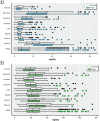Ingested Nitrate and Breast Cancer in the Spanish Multicase-Control Study on Cancer (MCC-Spain)
- PMID: 26942716
- PMCID: PMC4937871
- DOI: 10.1289/ehp.1510334
Ingested Nitrate and Breast Cancer in the Spanish Multicase-Control Study on Cancer (MCC-Spain)
Abstract
Background: Ingested nitrate leads to endogenous formation of N-nitroso compounds that are breast carcinogens in animals, but human evidence is limited.
Objective: We evaluated ingested nitrate as a risk factor for breast cancer (BC) in a multicase-control study.
Methods: Hospital-based incident BC cases and population-based controls were recruited in eight Spanish regions in 2008-2013; participants provided residential and water consumption from 18 years of age and information on known BC risk factors. Long-term nitrate levels (1940-2010) were estimated and linked with residential histories and water consumption to calculate waterborne ingested nitrate (milligrams/day). Dietary ingested nitrate (milligrams/day) was calculated using food frequency questionnaires and published dietary nitrate contents. Interactions with endogenous nitrosation factors and other variables were evaluated. A total of 1,245 cases and 1,520 controls were included in the statistical analysis.
Results: Among the study regions, average ± SD waterborne ingested nitrate ranged from 2.9 ± 1.9 to 13.5 ± 7.5 mg/day, and dietary ingested nitrate ranged from 88.5 ± 48.7 to 154 ± 87.8 mg/day. Waterborne ingested nitrate was not associated with BC overall, but among postmenopausal women, those with both high nitrate (> 6 vs. < 2.6 mg/day) and high red meat intake (≥ 20 vs. < 20 g/day) were more likely to be cases than women with low nitrate and low red meat intake (adjusted odds ratio = 1.64; 95% confidence interval: 1.08, 2.49; overall interaction p-value = 0.17). No association was found with dietary nitrate.
Conclusions: Waterborne ingested nitrate was associated with BC only among postmenopausal women with high red meat consumption. Dietary nitrate was not associated with BC regardless of the animal or vegetable source or of menopausal status.
Citation: Espejo-Herrera N, Gracia-Lavedan E, Pollan M, Aragonés N, Boldo E, Perez-Gomez B, Altzibar JM, Amiano P, Zabala AJ, Ardanaz E, Guevara M, Molina AJ, Barrio JP, Gómez-Acebo I, Tardón A, Peiró R, Chirlaque MD, Palau M, Muñoz M, Font-Ribera L, Castaño-Vinyals G, Kogevinas M, Villanueva CM. 2016. Ingested nitrate and breast cancer in the Spanish Multicase-Control Study on Cancer (MCC-Spain). Environ Health Perspect 124:1042-1049; http://dx.doi.org/10.1289/ehp.1510334.
Conflict of interest statement
The authors declare they have no actual or potential competing financial interests.
Figures

References
-
- Agudo A, González CA. Secondary matching: a method for selecting controls in case-control studies on environmental risk factors. Int J Epidemiol. 1999;28(6):1130–1133. - PubMed
-
- Bingham SA, Hughes R, Cross AJ. Effect of white versus red meat on endogenous N-nitrosation in the human colon and further evidence of a dose response. J Nutr. 2002;132(11) suppl:3522S–3525S. - PubMed
-
- Brody JG, Moysich KB, Humblet O, Attfield KR, Beehler GP, Rudel RA. Environmental pollutants and breast cancer: epidemiologic studies. Cancer. 2007;109(12) suppl:2667–2711. - PubMed
Publication types
MeSH terms
Substances
LinkOut - more resources
Full Text Sources
Other Literature Sources
Medical
